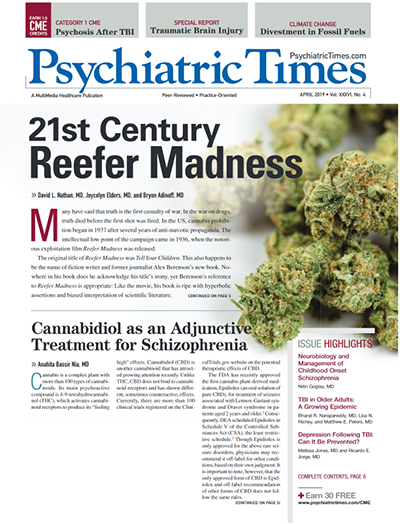Publication
Article
Psychiatric Times
Recognizing and Treating Trauma in the Inpatient Psychiatric Setting
Author(s):
Successful, trauma-informed care for patients with serious mental illness requires providers to assess, acknowledge, and treat trauma.
©Peera/AdobeStock

Compared with the general population, patients with serious mental illness are more likely to:
• Experience a traumatic event and have a higher number of overall trauma exposures1
• Meet criteria for a diagnosis of PTSD during their lifetime and in the previous 12 months2
• Report greater impairment in general functioning due to trauma2
• Have increased use of health care services related to trauma2
Previous research suggests that comorbid mental illness and post-traumatic stress interact to produce worse outcomes in patients, making trauma an important facet of a patient’s overall psychiatric care. However, diagnosis rates of PTSD in psychiatric inpatient treatment settings are consistently lower than expected given the rate of trauma exposure. It seems inpatient psychiatric treatment may focus more on primary psychiatric symptoms (eg, psychosis) that brought the patient in, while identifying and treating PTSD may be secondary.
Identifying trauma symptoms and psychological distress
Inpatient psychiatric outcomes data provide a unique opportunity to examine the presence of PTSD symptoms and diagnoses for patients with mental illness and how PTSD symptoms are related to overall psychiatric symptoms and functioning.
Data were analyzed for 4126 patient records with an Abbreviated PTSD Checklist (PCL-C-6) completed at admission to an inpatient psychiatric treatment program. The average admission severity for patients exceeded the suggested cutoff, indicating the likelihood of PTSD (patient average was 17.5 compared to cutoff of 14). A subset of these patients (29.6%) also had admission scores on the Behavior and Symptom Identification Scale (BASIS-32®), a measure of general functioning useful for monitoring behavioral health outcomes. Patients who scored at or above the cutoff on the PTSD screener had significantly higher levels of dysfunction on the BASIS-32 compared with patients who scored low (below the cutoff) on the screener.
Does routine trauma screening identify trauma in inpatient units?
Although the majority of patients (65.7%) had high scores on the PCL-C-6, only 7.6% of these patients also had a primary or secondary PTSD diagnosis. Those who were diagnosed may have just been the most severe: patients with PTSD diagnoses had higher PCL-C-6 scores and showed greater distress overall on the BASIS-32 compared with patients with high PCL-C-6 scores but no PTSD diagnosis. These findings suggest PTSD may be underdiagnosed in these populations, especially when symptoms of serious mental illness are at the forefront.
Clinical lessons
Our data support the presence and role of trauma in this population, and we see evidence of the need for trauma-informed care. Regardless of diagnosis, patients with serious mental illness and post-traumatic stress symptoms would likely experience benefit in both areas from trauma-informed care.
TRAUMA-INFORMED CARE does not mean only focusing on a specific traumatic incident; successful, trauma-informed care for patients with serious mental illness requires providers to do the following:
1) ASSESS TRAUMA: Recognition of a patient’s trauma can be achieved during the admission process via trauma screening. In fact, the current standards for accreditation by The Joint Commission (TJC) in behavioral health already require the use of such screeners. Current TJC estimates show roughly 95% of patients in accredited inpatient psychiatric programs are screened for trauma.3 Thus, many programs already collect these data, which should be made accessible and incorporated into treatment planning. In addition to admission screening, assessment of trauma and PTSD can easily be performed with the addition of a quick trauma screener, such as the PCL-C-6.
2) Acknowledge trauma: Once assessed, trauma can be addressed with patient psychoeducation and by entering diagnoses or progress notes into the medical record. If PTSD is present in a reduced form, a remission specifier or “not otherwise specified” may also be considered. Inclusion in the medical record provides a history of the patient’s experiences and encourages a clinical focus on all relevant issues. Moreover, noting PTSD in a chart allows the patient a record of his or her history, which encourages the continuation of trauma-informed care at follow-up once the patient leaves the current facility.4
3) Treat trauma: While PTSD can be a recurrent disorder that may not be fully treated in one inpatient stay, it is theorized that co-occurring PTSD and serious mental illness are best treated in conjunction. New evidence suggests popular treatments for PTSD can be used with patients with co-occurring serious mental illness, including psychosis.5,6 Unfortunately, many clinicians report not feeling equipped with the training they need to engage in trauma-specific treatment. Given the high incidence of trauma exposure and PTSD symptoms in the population of patients with serious mental illness, we believe continuing education and training in this area should be a core component of behavioral health care practice.
Disclosures:
Ms Nowlin and Dr Brown are data analysts for Mental Health Outcomes, LLC., a subsidiary of Universal Health Services, Inc, Lewisville, TX.
The authors report no conflicts of interest concerning the subject matter of this article. The views expressed in this article are the authors’ own and do not represent the official position of Universal Health Services, Inc. or of its subsidiaries, whose funding supported the data collection and preparation of the article.
References:
1. Mueser KT, Goodman LB, Trumbetta SL, et al. Trauma and posttraumatic stress disorder in severe mental illness. J Consult Clin Psychol. 1998;66:493-499.
2. Grubaugh AL, Zinzow HM, et al. Trauma exposure and posttraumatic stress disorder in adults with severe mental illness: a critical review. Clin Psychol Rev. 2011;31:883-899.
3. The Joint Commission. Comparison Rates: Q2 2018. https://www.jointcommission.org/performance_measurement.aspx. Accessed March 7, 2019.
4. Alexander AA, Welsh E, Glassmire D M. Underdiagnosing posttraumatic stress disorder in a state hospital. J Foren Psychol Pract. 2016;16:448-459.
5. Sacks SA, Schwartz B, Mueser KT. A pilot study of the trauma recovery group for veterans with post traumatic stress disorder and co-occurring serious mental illness. J Ment Health. 2017;26:237-241.
6. Swan S, Keen N, Reynolds N, Onwumere J. Psychological interventions for post-traumatic stress symptoms in psychosis: a systematic review of outcomes. Front Psychol. 2017;8:1-14.







